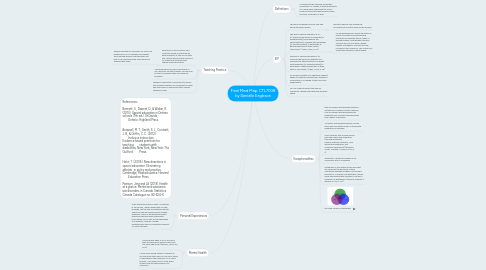Final Mind Map: CTL7008 by Danielle Eagleson
by Eaglesda21 .


1. Teaching Practice
1.1. Reflection on your practice and continual review of literature are both important to stay up-to-date and familiar with the best practices for supporting students that require special education
1.1.1. Special Education is necessary for some but beneficial for all. All students can benefit from learning different perspectives and how to be compassionate and supportive towards their peers
1.2. I will always have an open-door policy in my classroom so that students can feel free to talk to me should they ever have any problems
1.3. Teacher collaboration is important to ensure that student supports are consistent and that key information is shared to better support students' needs
2. References: Bennett, S., Dworet, D., & Weber, K. (2013). Special education in Ontario schools (7th ed.). St Davids, Ontario: Highland Press. Brownell, M. T., Smith, S. J., Crockett, J. B., & Griffin, C. C. (2012). Inclusive instruction: Evidence-based practices for teaching students with disabilities. New York, New York: The Guilford Press. Hehir, T. (2005). New directions in special education: Eliminating ableism in policy and practice. Cambridge, Massachusetts: Harvard Education Press. Pearson, Janz and Ali (2013). Health at a glance: Mental and substance use disorders in Canada. Statistics Canada Catalogue no. 82-624-X.
3. Personal Experiences
3.1. After having reflected on what I've learned in the course, I have realized that my own privilege, cultural and socialisations greatly affect my view and responses to student behaviour. Many of the behaviours that I observed may have been interpreted inaccurately on my part, as the expression of a disability, disorder or other exceptionality may be completely different for each individual
4. Mental Health
4.1. Young people aged 15 to 24 are more likely to experience mental illness than any other age group (Pearson, Janz & Ali, 2013)
4.2. I know from having talked to students in my practicum that many do not feel a sense of belonging in the classroom. As a future teacher, I will always aim to make every student feel like they belong in my classroom
5. Definitions
5.1. According to the Learning Disabilities Association of Canada, a learning disability is a neurological impairment to one or more processes that help a person think, perceive, remember or learn.
6. IEP
6.1. Should be reviewed once per year and during transition period
6.1.1. Transition periods can change the circumstances and the needs of the student
6.2. The goal of special education is to : “to minimise the impact of disability [or exceptionality] and maximise the opportunities for children with disabilities [or exceptionalities] to participate in general education in their natural community”. (Hehir, 2005, p. 49)
6.2.1. My understanding of special education is that it promotes inclusive teaching practices for students with all types of exceptionalities. With greater inclusion, students will not only have a higher chance at academic success, but feel included in the classroom. This is good for supporting students' mental health.
